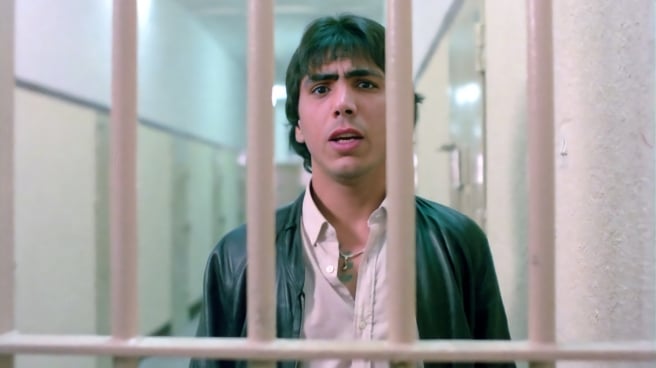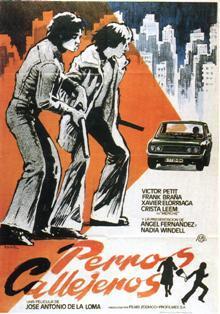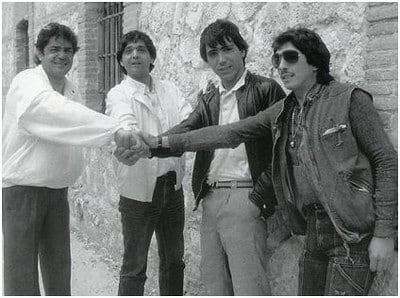

Juan José Moreno Cuenca, “El Vaquilla”, in the film by José Antonio de la Loma, based on his life.
He climbed onto the stilts and placed a cushion on the seat. He was 9 years old when he started stealing cars, and his feet couldn’t reach the pedals and his eyes couldn’t reach the front window. He always went with his older brothers, with whom he returned to spend the night in the house where his mother spent several days between sentences. At the age of 12, he was already known in the La Mina area as one of the best car thieves, and it was in the same year, when he took a woman’s purse from one of them, that he became a murderer, throwing her to the ground and running over her. .
He was 14 years old when he was first arrested and spent 28 years in prison until he died of cirrhosis in his early forties. During this time, he moved in and out of prison with great persistence, participated in escapes, riots, and his face constantly appeared in the news. Also the main character of films and songs. Even one of his escape attempts, which resulted in him being shot and handcuffed, was broadcast on Catalan television.
But who was El Wakilla, where did he come from and why do we all know his name? Juan José Moreno Cuenca was born while his mother was serving time in prison and was one of hundreds of young people who moved to the La Mina area when, at the end of the Franco regime, it opened its doors to shelter more than 15,000 people. the people who lived there, in slums near Barcelona and Sant’Adria. He was also the fourth child of Rosa Cuenca and the first child from the same father. As her mother told her, her conception was the result of a short relationship with a singer-songwriter, whom she never saw again, and after that there were others, from different fathers.
“They saw a nice car, someone in a Lacoste polo shirt, and they wanted to drive one or wear the other. But they had no money. That’s why they stole it.”
Apparently, he always had a more tense relationship with his older brothers, and it was they who taught him what to do in order to have. Years later, he said his first robbery happened at school, during one of the few courses he took. He took colored pencils from a classmate to sell them and pay for a game of table football. Then the bags and cars arrived very quickly. “They saw a nice car, someone in a Lacoste polo shirt, and they wanted to drive one or wear the other. But they had no money. That’s why they stole it,” he said. World police veteran about him and his family.
But one day, not far from that first robbery, he took a gun from a guard and, standing on stilts and a pillow, stole a car to go to the Costa Brava to “steal” tourists. It was there, while driving, that he reached out and stole the purse of a tourist who died in a fall and hit-and-run.

From then on, at age 13, he moved from reform school to reform school, and at age 15 he was transferred to the Model Prison in Barcelona. But luck was on his side, and an amnesty after Franco’s death left him free a year after entering. But that short stint in an adult prison did not act as an incentive. From then on, he was known to be in and out of prison quite often, and his career as a criminal was so fast that in 1977, José Antonio de la Loma asked him to appear in a film. Stray dogs where he talked about the life of children from the slums. He agreed without hesitation, but everything ended when he had to return to prison. Or not. Because this film, which started the “queen” genre, brought him even more fame in the media and helped him grow as a character.
The popularity that this film and the news gave him brought him such fame that in prison he became the protagonist and spokesman for all the subversive movements that took place. He was the instigator of several mutinies and rose to prominence in 1984 with the riot he led at Modelo Prison. That’s what the newspaper reported then. A country: “Rebel prisoners, among whom was Juan Moreno Cuenca, nicknamed Heiferand a boy recently transferred from Madrid, nicknamed Josele, abducted (four) officials with several knives and a stiletto, about 12:30, seized the Naves and closed the gallery. The rebels released two hostages when the prison doctor gave them the required doses of drugs, and the other two when they managed to convey to the media what they considered their demands.”
And just a year after this riot, which appeared on the front pages of all newspapers, his name began to be chanted on all the streets of Spain. Los Chichos, one of the most popular groups of the time, dedicated a song to him. The chorus said: “You are a heifer, a merry bandit / Because what you earn, you give away money / You are a heifer of good feelings / If in the end you depend on a simple jailer.” He was only 24 years old and was already a rock star at the time. In addition, in the same year he was played in the film by Raúl García Lozada, as well as Loma. Me, Chick which expanded the myth.

But he continued to be in and out of prison and learned that his heroin addiction had given him AIDS and hepatitis C. He lived, accepting the disease and his little free will, until he decided to escape in 1999 and be free for five full years. days. In the little over 100 hours he spent on the streets, he committed thirteen crimes that landed him back in court and back behind bars. At this trial, he assured: “Theft is wrong. I committed a crime and take responsibility.” What he didn’t know was that this would be his next, but also his last, proposal.
Because, although he was young, AIDS and hepatitis combined with cirrhosis of the liver ended his life on December 19, 2003 in the Badalona prison hospital. He was 42 years old.
Therefore, although with some delay, the song Elegy Ismael Serrano also bore his name. “Even before you were born, you were already bloody meat, / then you drank mirages through a needle / There has never been so much rage in the cell / and cirrhosis of the liver thwarted your last escape / Justice is inexorable / with those who have no money / and there is only resistance./ Life on the periphery,/ is cruel, always opens a wound,/ you were its scar.
Source: El Independiente